
Adult male - Image courtesy of igmillichip
I forget how many times folks have asked me for help with hatching annual killifish species eggs bought from Far East breeding farms via online sources such as Ebay. I hope this little scenario, which happened to me recently, helps others who have unwittingly gone down the same route and acquired eggs which they were ill equipped to cope with.
OK I usually start these threads with the sum of the whole. I usually tend to complete an opus start to finish before submitting the finished article for everyone's perusal. This time around, through a catalogue of events I'll be doing things a little differently, and logging certain (providing everything goes to plan) events on a day to day or weekly basis.
Let me give you a little background to the situation in hand. Ordinarily I would post a breeding article starting with the fish spawning, egg production, hatching, rearing of fry, so on and so forth. This time a situation was forced upon me somewhat on which I had to act.
Some time ago I was approached by a young lad who was interested in Killifish. Knowing little or nothing surrounding their care and husbandry, he proceeded, like many before him to purchase some Annual species eggs from so called Far East breeding farms. He chose Nothobranchius rachovi (Beira 98) as his first species on which to start his new found hobby. Now as we all know, or should know, Rachovi is a very colourful fish, one that will rival a lot of marine species in that respect, but in no way is it, IMHO, a beginners species. Had he contacted me sooner I would have recommended Guntheri as a species on which to cut his teeth as it were. Anyway the sceanario played itself out and finding out that he was ill prepared for their imminent hatch (no food stuffs readied) he asked would I hatch the eggs for him. Not wanting to let the chap down I duly agreed to hatch the eggs and once successfully reared I would return him a couple of pair of which he was more than delighted. This gave him the opportunity to gather more information on the subject and be better equiped next time when it's his turn to give them a go. He sent me the eggs and the story progresses from this point onward.
I received the eggs and the first thing that alarmed me was the collection and hatching dates.
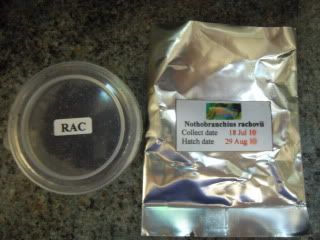
Collected 18/07/2010 - Expected 29/08/2010
Now I know enough from breeding this species many times in the past that something was more than likely amiss here as the drying period for Rachovii (although you can warm store to force the diapause to quicken) is around 4mths give or take. (check the iris within the egg sac for an indication of hatching) Not entirely happy with this information I stored the eggs for a further six weeks than what was advised on the label. (still a very short diapause for RAC) but this depends a lot on the moisture of the peat and temperature of incubation.
Today I decided to wet the eggs for the first time.
So I made up some coolish water (68'f) in a small margarine tub, 1/2 tapwater - 1/2 rainwater and a slight sprinkle of salt to deter velvet.
Fry began hatching almost immediately so armed with my little torch and pipette I prepared to go hunting Rachovii fry.
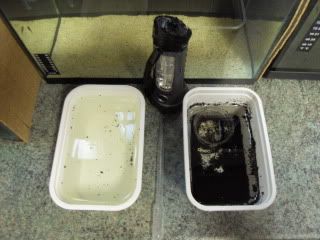
It was at this point I realised "My Eyesight is getting worse with age"! I had totally forgotten how small these little beggars were, especially as they had the camouflage of the peat to help them evade detection. Next out came the trusty large magnifying glass and the hunting ground became a whole lot clearer. As of one hour ago we were up to 16 fry, not a lot you might say but there are more to be caught and I've retired for this evening to resume in the morning. I have no idea how many eggs were in the peat to begin with as those Far Eastern farms are notorious for dubious practices when sending precise numbers of eggs. So we'll see how many we eventually end up with in the first batch before re drying the peat.
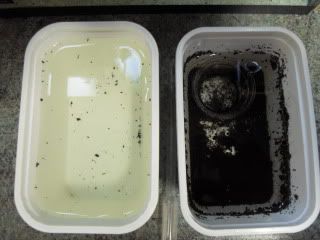
For now, the fry are being fed paramoecium. Annual fry need to be fed immediately upon hatching. Whilst there will be a certain amount of infusoria available via the peat they will still need a hearty meal soon after. They are too small in the first stages to accept artemia nauplii so we need to offer microscopic livefoods to get them to the next stage.
That's were we are at this present moment in time, tomorrow's another day as they say, success, failure who know's what factors will come into play as we progress. That remains to be seen.
These fry are tiny in comparison to a lot of other Notho. species I've encountered.
I will hopefully embellish this thread further with images depending on the outcome of ongoing events. Once I can get them to the brine shrimp stage then everything should be plain sailing. Fingers crossed.
--------------------------------------------------------------------------------------------------------------------------------------------------------------------------------------------------------------------------------------------------------------------------------------------------
Whilst the situation is developing please allow me to fill in some basic information surrounding this beautiful species.
Nothobranchius rachovii, belongs to the family of the Cyprinodontidae. This amazingly colourful Notho. was first discribed by by E. Ahl in 1926 and was named in honour of Arthur Rachow, a renowned pre-world war German aquarium pioneer.
There are many different strains of RAC known to the hobby today, some readily available, some fairly obscure. Most are pretty much unrecognisable from the colour pattern that we all perceive to be Nothobranchius rachovi. Although still classified as the same fish separated only by locality they bare little or no resemblance (in colour) to the "*normal coloured" Beira strain.
N. Rachovi's distribution area is pretty vast but predominately lies within and along the border areas of Mozambique with one particular location being found just across the border with South Africa.
Known populations are;
Beira 98
Kruger National Park
MOZ 03-2
MOZ 04-02 Mazimechopes River
MOZ 04-08 Lima River
MOZ 04-10 Nicuadala
MOZ 04-3
MOZ 04-9 Quelimane
MOZ 99-9
MOZ 99/1
MOZ 99/3
MZHL 05-5
Nhangau MT 03-4
This species of fish will attain a size of around 55-60 mm for the males with female remaining slightly smaller.
I wish to include (from published literature) a little description of Beira the main type locality of this species.
In Beira, the soil content of this location is made up of salty red clay the coolest temperatures (average of 22.5°C - 72°F) can be found in July. During the hottest period (November-December) the average temperature reach 27.5°C (82°F). The temporary pools will start to dry out around May or June. The rainy starts in November, and by June -July most of the pools containing RAC will have totally dried out. The eggs of coastal RAC populations incubate in semi moist soils for approximately 5-6 months (hence my concerns over the hatching dates on the eggs supplied to me albeit the diapause times would be temperature dependant).
The area around Beira is made up of a great number of swamps and marshland which in-turn generates a unique micro-climate controlled by sporadic foggy night-time clouded areas which generate early morning dew, this stops the developing eggs from fully drying out.
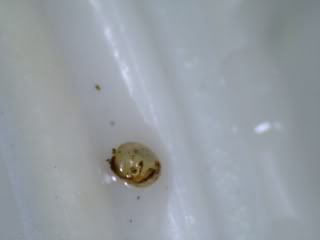
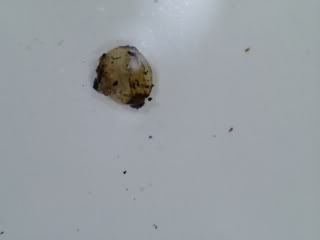
These images show a RAC egg (from this batch) with still some way to go before hatching.
There is a fair amount of cell division with skeletal formation &
if you observe the second photo closely you may just be able to locate the eye.
This egg along with any others that are left in the peat will almost certainly need a further resting period before it's time for the fully developed fry to emerge.
Often folks would often wonder what is termed by annualism or what does it mean that a specific genre or species of killifish is classed as an annual type. For the benefit of those enquiring minds I will attempt to briefly explain.
When we speak of the term annual killifish we are usually referring to a genre or species of Cyprinodontidae who's eggs require resting period in which to develop. Most annuals come from Africa and South America. They are fish that posses a very high metabolic rate. Their life-cycle is governed by climatic changes in weather patterns in their relevant geographical locations. Rains fill temporary water holes (sometimes only the size of a cattle hoof imprint) The eggs hatch out almost immediately and the tiny fry search for food. Annual species are constant eating machines and provision for a well stocked live food larder is a necessity when handling such species. They grow very fast, they have to as they will only have the time available until the hot sun dries their pool. They usually mature in around 4-6 weeks (sometimes shorter) and begin to breed, this is their sole occupation from this moment onward, (Normal lifespan for the Beira strain is between 9-12 months). At the latter end of this timescale the fish will look very ragged and a shadow of their former self.
As the pools begin to dry the egg develops normally until a specific number of cells has been reached then it will enter a resting stage or diapause (different species will have 2-3 different resting stages). These stages are again linked to the weather patterns of the area in which they live. When the rain starts to fall again the fry will hatch and start the cycle all over again. One point to note is that not all eggs will hatch at this moment incase of a premature freak storm, some eggs will be at differing stages of development and may not hatch (in the wild) until the following season. Nature has thought of everything to ensure the survival of such complex species of fish.
Must go and check these eggs and fry again.
----------------------------------------------------------------------------------------------------------------------------------------------------------------------------------------------------------------------------------------------------------------------------------------------
***Just finished checking the peat for any more hatchings and I can report another four have been transferred to the small rearing tub. That brings us up to around the twenty mark but I will keep the peat submerged for another 48 hours in-case there are any stragglers after which time I will re-dry and store the peat for a further 4-6 weeks and start this process again.
There has been no losses overnight I'm glad to say and I have performed the first of many minute water-changes using the same water make-up as before. This being agitated with 1 teaspoon of salt per 10ltrs of make-up water.
Water-changes are very, very important at this stage but they can also be fatal if you use a different chemical balance. It is good practice to make up around 10 extra litres of water specifically for use with this species when you first wet the eggs. Small and frequent daily water-changes are best, and I would only like to change around 30mls per day at this point. Later we can increase the amount of change. Always remember to keep the tubs clean, this is paramount.
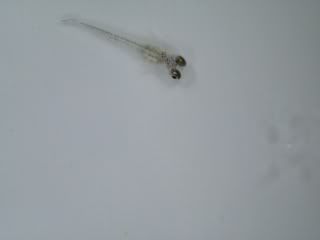
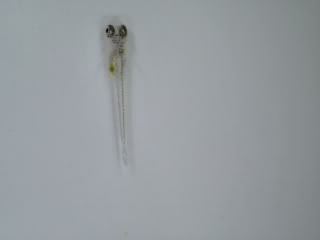
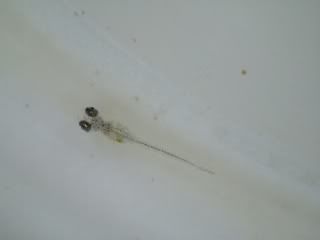
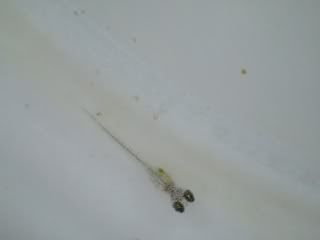
Images of day old Nothobranchius rachovii Beira98 fry by the Author.
So for now at least everything is going to plan, next step will be to increase the feeding regime and introduce microworm followed shortly after by newly hatched brine-shrimp. When I say newly hatched I mean exactly that, as Artemia nauplii can double in size after 24 hours and loose quite a lot of nutritional value in the process which is negative of what we want.
On we go!
-----------------------------------------------------------------------------------------------------------------------------------------------------------------------------------------------------------------------------------------------------------------------------------------------
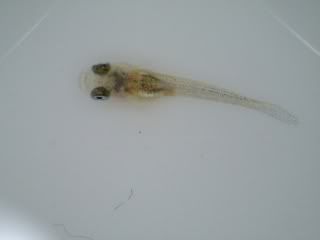
The Rachovii fry are now approx one week old.
They are feeding on Brineshrimp nauplii/Microworm 3 times per day with no problems. 50% waterchanges are being performed daily with the same chemical make up as they were hatched in.
I have lost one straggler in this process, there are, as always a couple more who are not keeping up with the pace so I will allow them a couple more weeks before the cull. Heartless I know but there's no point to keeping sub-standard fish. IMO
Today I redried the peat in the hope for a second hatch.
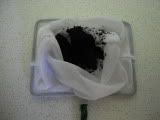
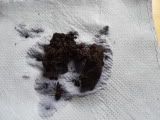
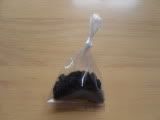
First the peat was strained through a fine mesh net then placed on some absorbent tissue and allowed to dry out somewhat to the consistancy of rolling tobacco. Finally the peat is bagged and sealed with a little air. After labeling, the packet is then stored in an dark warm place for a further 2 weeks, whereby the peat will be re-wet.
This is normal proceedure when dealing with any annual Killi eggs, and one would expect to get some more fry from the second hatch, possibly even surpassing the first. As these eggs were originally from the Far East the liklihood of obtaining a good second hatch must be questionable, but we'll wait and see.
---------------------------------------------------------------------------------------------------------------------------------------------------------------------------------------------------------------------------------------------------------------------------------------------------
It's been a while since I updated this thread/journal so let me put that to rights now with notes I'd written down since the last instalment.
21/11/2010
The fish are now growing at pace and I will soon have to introduce a pot of peat into their aquarium (in the next week or so) to provide them with somewhere to deposit their eggs. Of the four males, one is a cracking fish, very well marked and good body shape. This will be my main brood male for subsequent generations. I have developed a love for this little species once again and may decide to keep and breed these long term. They are a little finicky to hatch and feed the fry but it's well worth the effort when you see the resulting males.
Pics to follow....
24/11/2010
Re-wetting the peat after a few weeks yielded only 5 more fry. Not a great result but it was performed just to show that it is possible to have more resting eggs within the peat mass which have not finished their diapause stages. It is now time to set the original batch up with a view to breeding. There is no time to waste, annual killifish mature quickly and will soon be ready to breed.
The substrata that I like to use for breeding annual killifish species is peat, in pelleted form. You can purchase these from your local garden centre.
I like to use plastic receptacles such as the image above. I place one pellet into the pot and add some tank water , the pellet will now swell and become waterlogged. It is now ready to be slowly added to the tank.
The males are now forming a hierarchy and the dominant male is trying to spawn with the females so we now need to add some medium for them to deposit their eggs into.
Nothobranchius rachovii are what we term as peat ploughers rather than actual divers such as some of their South American counterparts. The male will drive the female into the peat medium from above and behind, he will wrap his dorsal and anal fins around the female and shimmer until you will notice a slight "jerk" motion at this point a single egg will have been deposited just below the surface of the peat and fertilised by the pressing male. The female will then be released. The male will either perform the same act with the same female again or he will chose another. Either way this will become a continuous cycle of events from now until the fish expire.
05/12/2010
As time passes in their short lifespan...
The females dont seem to be getting the breeding container idea, I think it's the steep sides, alas the male lays in wait forlornly within the pot.
I may have to resort to a shallow sided lunch-box type of spawning receptacle. The transparent pint pot idea was to present me with the ability to let folks see (via an embedded video) the typical Notho spawning behaviour. Although this may still be possible, we'll wait and see what transpires when I install the new box.
Interestingly enough this species will eat frozen mini Bloodworm & Tubifex something which I have trouble with getting Nothos to consume in the past. So thats a plus.
To be continued...
-----------------------------------------------------------------------------------------------------------------------------------------------------------------------------------------------------------------------------------------------------------------------------------------------------









